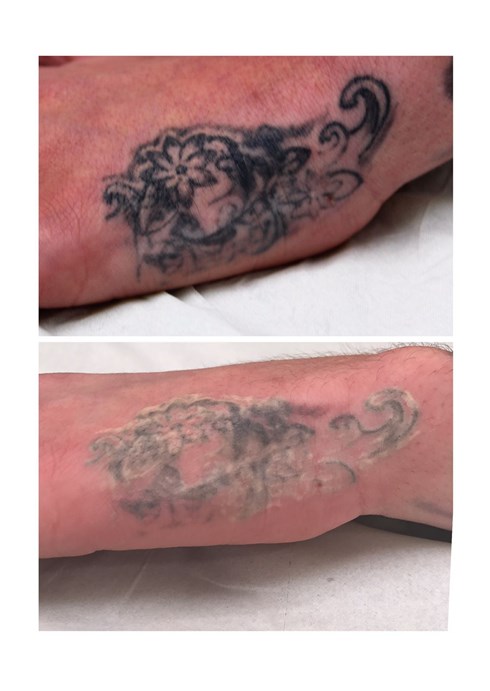Are all Tattoo Lasers the Same?
NO!
Always ask questions and do your research! Can my tattoo even be removed by a laser? Are the lasers used for tattoo removal all the same? How do I compare? There is more than one way to remove a tattoo and some techniques work better than others! Lasers are the most effective on certain colours of ink contained in a tattoo. Black and red are easy to remove while lighter colours are more challenging.
First, ask if they have a laser designed specifically for tattoo removal. Second, make sure that laser contains the laser wavelengths needed to remove your tattoo ink. Ask for the manufacture name and you can read about it on their website.
How does the treatment work?
Each pulse of the laser sends light energy into your skin. We use different wavelengths of laser light to treat different colours of ink in your tattoo. As the light energy is directed into your skin, it is selectively absorbed by the tattoo ink particles trapped in the dermis of your skin. When the ink particles absorb this energy, they instantly shatter into tiny fragments. Once the laser has broken the ink into smaller pieces, your body's immune system works to remove the ink over the following weeks, flushing it away from the tattooed area. We see the result of this as the tattoo lightening in appearance. Each additional laser treatment breaks down more and more ink until the tattoo can no longer be seen. Make sure that your provider has the proper laser that targets the proper laser wavelength for your tattoo.
How often can I have the treatment?
To allow the skin enough time to heal between treatments and the body's immune system to flush away ink, we recommend a minimum of six weeks between laser sessions – and eight weeks for darker complexions. Stacking the treatments too close together can cause damage and permanent side effects to the skin, such as scarring and blister burns. We always need to allow the body enough time to remove the ink that was shattered at the most recent session. Analysing the number of treatments a tattoo will need for removal. The clinians will need to take into account the following factors that affect the rate of removal: Fitzpatrick skin type Tattoo layering (if the tattoo is a cover-up) Location on the body Ink colour Amount of ink (vividness of tattoo, if it was professionally applied) Pre-existing scarring The speed of removal depends on the patient and their tattoo.
Will I be able to withstand the discomfort?
It’s not secret tattoo removal has a bad rap for it being painful. The discomfort depends on your individual pain tolerance and where the tattoo is located. Fortunately there are ways to numb the skin to make the treatment more comfortable. The most popular numbing method is a Zimmer Cryo 6, which is a powerful chilling machine that blows cold air on the skin before, during, and after treatments. It's highly effective and an asset to our clinic. Our clinic’s loved it! Do
I need to do anything at home?
Even if the treatment is performed properly, scarring can happen when patients fail to follow aftercare instructions. Blisters and scabs are common side effects that are important in the tattoo removal healing process. However, picking scabs or not caring properly for blisters can allow scarring to happen.
Not all lasers are the same! When discussing aftercare with our clients, we make sure we emphasize their role in the outcome of their tattoo removal. Please call 01639 891200 to book your free skin consultation .
